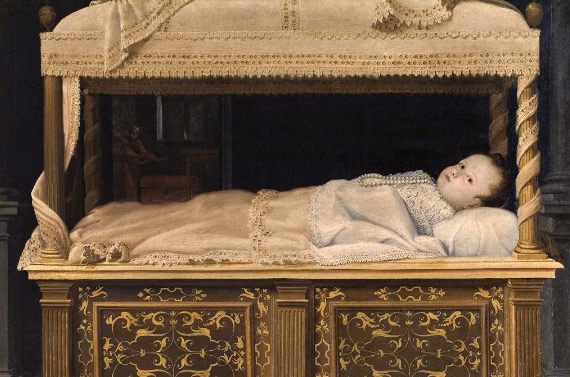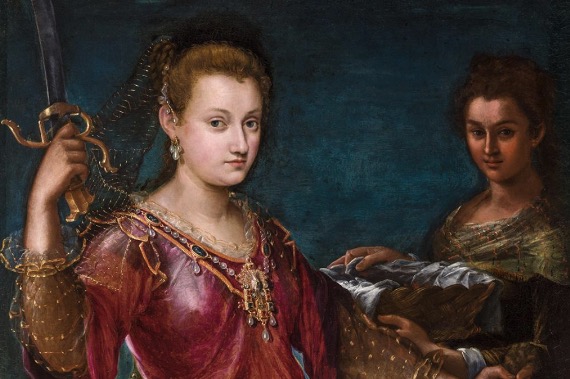The best thing about the obsession with identity that currently drives art is the array of new voices it has forced into the open. At both extremes of art’s spectrum — old masters at the beginning, ultra contemporaries at our end — we are encountering an expanded cast. True, the me, me, meism on the contemporary side has grown repetitive and tedious (“I beg you Ancient Mariner, don’t tell me your story!”), but among the old masters the discoveries continue to excite.
Lavinia Fontana (1552-1614) was from Bologna. Her dates place her in that fuzzy, fertile, underexplored phase of art we call “Mannerism”. Squeezed between the Renaissance and the Baroque, Mannerism has been ignored. But among its many radical contributions was the unveiling of a new voice in art: that of the female artist.
The story is detailed in Lavinia Fontana: Trailblazer, Rule Breaker, a rousing display at the National Gallery of Ireland in Dublin. What small fame Fontana already has rests on her reputation as the first female painter of nudes. It turns out she could list many significant achievements in her CV.

The most telling was, of course, just being there. Her era produced the first female painters because it was an epoch of expansion, not just in its range of artists but also in its range of patrons. While the Renaissance relied almost exclusively on the church and royalty for its commissions, the mannerist age added an art-hungry merchant class and a growing urban nobility. And they all wanted their portraits done.
The opening rooms, one devoted to men, the second to women, unveil the faces of a pushy urban citizenry that had finally found an antidote to eternal obscurity. A visiting friar, having come to preach in Bologna for a year, commissions a record of his visit. A minor count from a minor town sticks out his chest in a major pose.
The men are competent, but it’s when Fontana turns to women that the event starts to sizzle. The first example is her own face. In a couple of exquisite self-portraits, one showing her in her studio, the other showing her playing a spinet, she fixes us with a stare that turns the business of looking at art into something prickly. She isn’t just describing herself, as portraiture had done until now. She’s shoving her presence out of her world and into ours.
There’s something new as well about the dressing-up involved: the taking on of a persona. Today we are used to self-portraits in which the artist acts out a role: the costumed me. But it’s not something art did before mannerism’s women took up the brush. In her portraits of Bologna’s female cast, Fontana’s interest in clothes blossoms. She’s good at many things, but ease turns to brilliance in her treatment of fabrics and jewels. By the time we reach the huge, multifigure showstopper that is generally counted as her masterpiece, The Visit of the Queen of Sheba to King Solomon, from 1599, the row of lace ruffs worn by the parade of attending noblewomen is more exciting than their faces. Lean in to examine it and you find yourself enjoying a row of miniature Jackson Pollocks.

Another speciality was children. Remarkably she had 11 herself, yet still managed to maintain a full career painting other people’s. Indeed, her husband, Gian Paolo Zappi, whom she married in 1577, can also claim to be something original: the first house husband in art. While Zappi stayed at home and looked after the kids, Fontana became the busiest and most empathetic painter of children art had so far seen.
The captions remind us that infant mortality rates were high at the time and that many of Fontana’s portraits of children were painted posthumously as acts of remembrance. Of her own 11, only three outlived her. So, again, something personal is being added here. Something new.
Having softened us up with all this sensitive pioneering, the show finally reaches the most notorious of its stretches: the first nudes painted by a woman. In Venus and Mars, the god of war slaps the naked bottom of the goddess of love like a porn star in an LA movie. In Venus and Cupid, from 1592, something tangibly transgressive is going on between the beautiful goddess in the see-through top and the bow-wielding son whispering in her ear. And look how her stare drags us deep into the naughtiness.
The biggest nude, Minerva Dressing, shows the goddess of wisdom about to put on her clothes. But see how complicitly she peeps out at us. As if she’s just taken them off.
The wall texts draw our attention to the cellulite Fontana has noticed in her naked goddesses. It is pointed to as evidence of an intimate knowledge of the female body. Fontana clearly knows a thing or two about the mechanics of desire. So there’s some sly button-pushing going on as well.
We’re still in the early stages of understanding her output. It can be uneven. Sometimes, especially among the society portraits, she’s run of the mill. But then she’ll do something notable and her art starts to glow. It happened for me with her version of Judith with the Head of Holofernes. The same subject would soon be turned into a baroque blood bath by Fontana’s successor Artemisia Gentileschi, whose ferocious Judith decapitates the predatory Holofernes with an enthusiasm many have identified as a woman’s point of view.
Fontana’s Judith is more thoughtful. She thrusts the head of Holofernes into the shadows and allows the light in the picture to illuminate her own face instead. Again, she fixes us with a penetrating stare. Again, it’s probably a self-portrait.
Lavinia Fontana, National Gallery of Ireland, Dublin, until Aug 27
